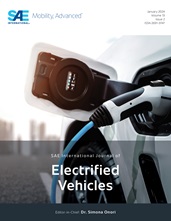Electric vehicles (EVs) represent a significant stride toward environmental
sustainability, offering a multitude of benefits such as the reduction of
greenhouse gas emissions and air pollution. Moreover, EVs play a pivotal role in
enhancing energy efficiency and mitigating reliance on fossil fuels, which has
propelled their global sales to unprecedented heights over the past decade.
Therefore, choosing the right electric drive becomes crucially important. The
main objective of this article is to compare various conventional and
non-conventional electric drives for electric propulsion in terms of
electromechanical energy conversion ratio and the thermal response under
continuous [at 12 A/mm2 and 6000 rpm] and peak [at 25
A/mm2 and 4000 rpm] operating conditions. The comparative
analysis encompasses torque density, power density, torque pulsation, weight,
peak and running efficiencies of motor, inverter and traction drive,
electromechanical efficiency, and active material cost. This study considered an
array of electric traction motor types and their accompanying power converters,
including the interior permanent magnet synchronous machine, induction machine,
PM-assist synchronous reluctance machine, synchronous reluctance machine,
switched reluctance machine, double-stator switched reluctance machine, and
double-stator PM synchronous machine. To ensure fairness, all machines share
identical outer stator diameters, stack lengths, and current densities. Drive
efficiency was assessed using uniform inverters via Ansys Simplorer, while Ansys
Fluent was used to conduct consistent thermal analysis to evaluate temperature
and cooling effects across all seven machines. Additionally, AVL Cruise M
software was utilized to compare the performance of these electric drives under
the Worldwide Harmonized Light-Duty Vehicles Test Cycle (WLTC) to simulate the
urban, suburban, rural, and highway driving conditions using the Nissan Leaf as
the reference electric vehicle.
